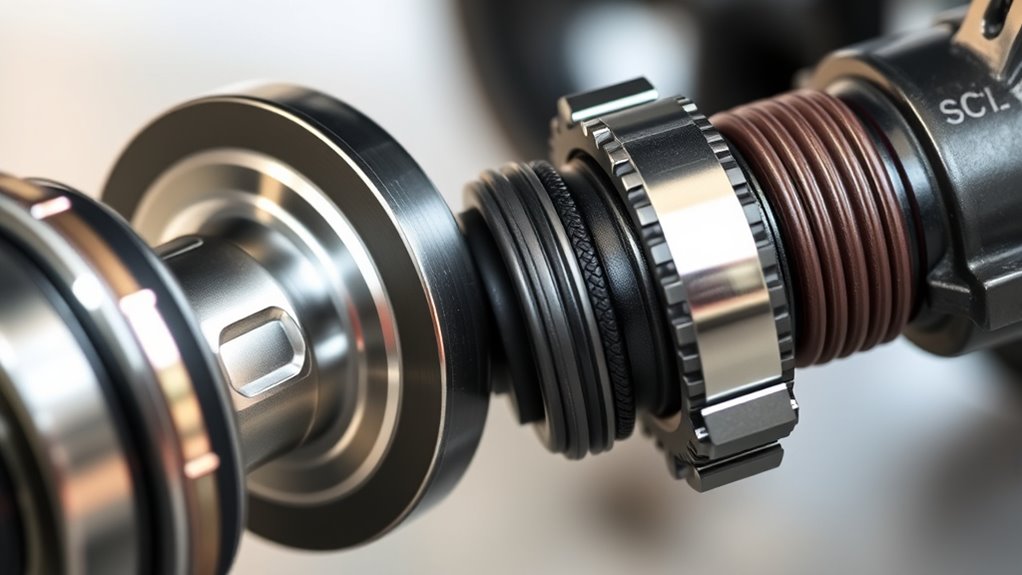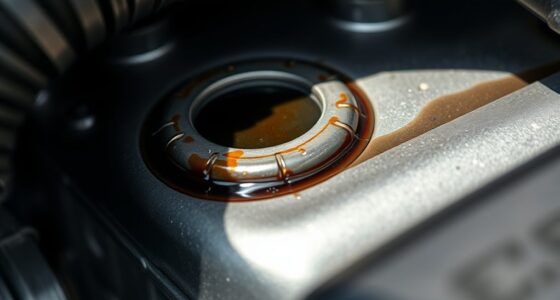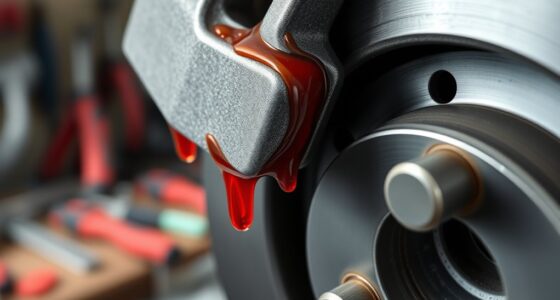Drive axles and CV joints are key parts that transfer power from your transmission to your wheels, allowing smooth turns and handling. The CV joints enable flexibility as your wheels turn and suspension moves, preventing vibrations and noise. Signs of wear like clicking sounds or vibrations mean you should get them checked. Proper maintenance, like wheel alignment and regular inspections, helps extend their lifespan, so keep going to discover how you can keep these components in top shape.
Key Takeaways
- Drive axles transfer torque from the transmission to the wheels in front-wheel and all-wheel drive vehicles.
- CV joints allow flexible movement, enabling smooth steering and suspension motion while transmitting power.
- Signs of CV joint wear include clicking noises during turns and vibrations while driving.
- Proper wheel alignment and suspension maintenance help prevent uneven wear and extend component lifespan.
- Regular inspections of drive axles and CV joints ensure early detection of issues, reducing costly repairs.

Drive axles and CV joints are indispensable components that transfer power from your vehicle’s transmission to the wheels, enabling smooth motion and handling. Without them, your car wouldn’t be able to move effectively or respond properly to steering inputs. These parts are especially critical in front-wheel drive and all-wheel drive vehicles, where they handle both power delivery and steering. As you drive, you might not think about these parts until they begin to show signs of wear, but understanding their role can help you recognize when maintenance is needed.
Drive axles and CV joints transfer power and enable smooth handling in your vehicle.
Your drive axles consist of an axle shaft connected to CV joints at each end, which allow for flexibility as the wheels turn and the suspension moves. The CV joints are designed to transfer torque smoothly, even when the suspension system causes the wheels to move up and down or turn. Over time, the constant motion and exposure to dirt, water, and debris can lead to wear and tear on the CV joints, often resulting in clicking noises during turns or vibrations while driving. When these symptoms appear, it’s a sign to inspect the CV joints and consider replacing them before more serious damage occurs.
Proper wheel alignment is essential for maintaining the health of your drive axles and CV joints. Misalignment puts uneven stress on these components, accelerating their wear and potentially causing premature failure. If your vehicle pulls to one side or if your steering feels off, it’s a good idea to check the wheel alignment. Correct alignment ensures that your suspension systems work efficiently, reducing unnecessary strain on the axles and joints. When suspension systems are properly maintained and aligned, they help distribute forces evenly across the wheels, prolonging the lifespan of the drive axles and CV joints.
In addition to wheel alignment, regular inspections of your suspension systems play a significant role in prolonging the lifespan of your drive components. Worn suspension parts, such as bushings or struts, can cause excessive movement or misalignment, which in turn impacts the CV joints and axles. Maintaining your suspension systems not only improves ride comfort but also reduces the risk of uneven wear on drive components. When you notice steering issues, unusual noises, or vibrations, it’s important to have your suspension systems, wheel alignment, and drive axles checked by a professional.
Understanding how drive axles and CV joints work within your vehicle’s overall drivetrain helps you appreciate the importance of routine maintenance. Regular inspections, proper wheel alignment, and a well-maintained suspension system are your best defenses against premature wear and failure of these indispensable parts. Proper maintenance practices can significantly extend the lifespan of these critical components, saving you money and ensuring safety on the road.
Frequently Asked Questions
How Do Drive Axles Affect Vehicle Handling?
Drive axles directly impact your vehicle’s handling by influencing axle alignment, which affects how smoothly your car drives. Properly aligned axles ensure consistent steering response, making your turns more precise and predictable. If your axles are misaligned or damaged, you might experience uneven steering or pulling to one side, reducing control. Regular maintenance helps keep your drive axles in good condition, guaranteeing ideal handling and safe driving.
What Are the Signs of CV Joint Failure?
Imagine your vehicle’s CV joint as a flexible dancer in perfect harmony. When it fails, you’ll notice clicking noises during turns, especially sharp ones. You might also feel vibrations or clunking sounds, indicating CV joint lubrication has deteriorated. Poor drive shaft balance can worsen these issues. If ignored, the joint could seize, leaving you stranded. Keep an ear out for these signs to prevent costly repairs and ensure smooth handling.
Are There Different Types of Drive Axles for AWD Systems?
Yes, there are different types of drive axles for AWD systems, including half-shaft axles, solid axles, and independent axles. Each type offers unique benefits depending on your vehicle’s design and driving needs. When considering types comparison, it is vital to also think about axle maintenance; regular inspections and lubrication help guarantee smooth operation and longevity. Knowing the right axle type for your AWD system keeps your vehicle performing reliably.
How Often Should CV Joints Be Inspected?
You should inspect your CV joints every 30,000 miles or if you notice clicking sounds during turns. Did you know that neglecting this can lead to joint failure, costing you hundreds in repairs? Follow a proper lubrication schedule and stick to recommended inspection intervals to catch issues early. Regular checks help guarantee smooth operation and extend your vehicle’s lifespan, keeping you safe on the road.
Can Drive Axles Be Repaired or Only Replaced?
You can often opt for drive axle repair if the damage is minor, like bent shafts or worn-out parts, but in most cases, replacement is necessary. When CV joints are failing, CV joint replacement is typically the best solution to restore proper function. Don’t ignore symptoms—timely repair or replacement guarantees safety and prevents further damage, saving you money and hassle in the long run.
Conclusion
As you turn the steering wheel and accelerate down the road, your drive axles and CV joints work seamlessly beneath you, like silent dancers coordinating every move. Their smooth rotation guarantees your journey remains effortless, even over rough terrain. When maintained properly, they become the heartbeat of your vehicle’s motion—reliable and resilient, whispering promises of countless adventures ahead. Trust in their quiet strength, and let your drive continue with confidence and grace.









